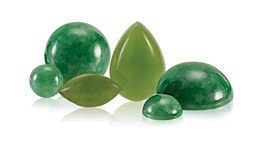Jade
Hardness: 6.5-7 Mohs
Enhancement Code: Natural
Quality Information:
Standard: Medium bright green; translucent to opaque; medium dome
Care: Rated “fair” for everyday wear with care. Avoid exposure to heat, contact with chemicals, and protect from scratches and harsh blows. To clean, gently scrub with a soft toothbrush and a solution of mild dish soap and warm water, or clean in an at-home ultrasonic unit.
Major Sources: Brazil, Europe
As with nephrite, jadeite is a form of jade. Able to be carved into shapes varying from axes to statues, jadeite was highly treasured by the Olmec and Maya cultures of Mesoamerica in addition to cultures across Eurasia. One of the oldest stones to be worked, jade continues to be treasured today.
An intense, translucent green, jadeite is shown to advantage in smooth forms, such as beads and cabochons. It works beautifully in all designs, from the traditional to the most modern.
Nephrite Jade
Hardness: 6-6.5 Mohs
Enhancement Code: Natural
Quality Information:
Standard: Medium to medium dark apple green; good cut; good polish; low dome
Care: Rated “fair” for everyday wear with care. Avoid exposure to heat, contact with chemicals, and protect from scratches and harsh blows. To clean, gently scrub with a soft toothbrush and a solution of mild dish soap and warm water, or clean in an at-home ultrasonic unit.
Major Sources: Australia, Canada, China, New Zealand, Taiwan
One of two stones known as “jade,” nephrite has been treasured since Neolithic times. Originally valued for its toughness, jade was carved for weapons and tools. By 3000 B.C. it was considered a royal gem by cultures from imperial China to ancient Egypt to the Maori of New Zealand. Its value was comparable to gold and diamonds.
Often given to honor 35th anniversaries, the state gemstone of Alaska represents strength, love, harmony and balance.






